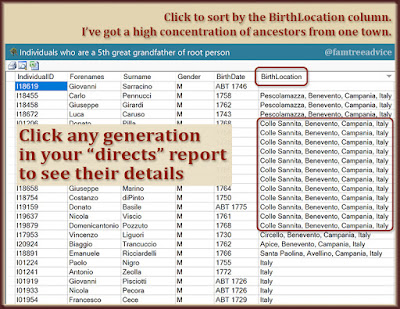I saw someone in an online genealogy group mention a book about building your family tree. The book said to research and build each of your 4 grandparents' lines one at a time. One at a time!
People in the group (including me) laughed at the idea. How do you choose where to start? How can you ignore information that falls into your lap about another grandparent?
I recommend a much less rigid approach. Genealogy is a hobby, not a requirement. If you're not having fun at it, you're doing it wrong.
When you start out, which branch to follow may depend on:
- Which documents are available
- Who's on your mind at the time
- Whatever you find that interests you.
After you've made some progress, follow your heart. I spent years (about 2008–2012) researching my mom's father's ancestry. Back then, his town's vital records weren't online. Research meant spending countless hours, and a little money, viewing microfilm in a church somewhere.
Those records were the biggest and shiniest genealogy object I could imagine. I set out to learn every possible name in my grandfather's family tree.
Then the Italian vital records started coming online. I jumped into my dad's father's ancestry. Why him? My 2 grandfathers left Italy to come to New York. My grandmothers were born in New York to Italian immigrants. I wanted to know about the families left behind.
You may wonder if you should stick to a plan and ignore the latest shiny genealogy object. Genealogy isn't a race to the finish. Yes, you want to learn about all your ancestry. But you need to have fun, too. It's the fun and joy of new discoveries that'll keep you going.
So, what's the next place for you to focus your attention? It depends.
Many times I launch Family Tree Maker without knowing what I'm going to do that day. This weekend I decided to search for missing documents. I opened my Document tracker spreadsheet and looked at the Need to Find column. I wanted to find missing records for my relatives who never left Italy.
Then one thing led to another. I was going through the spreadsheet alphabetically. I noticed I'd never researched Concetta Basile's husband, Giambattista Martuccio. I found his name written in the column of Concetta's birth record with their marriage date. And that was all I had.
Giambattista became my shiny object. I found his birth record and learned his parents' names. I found his mother's birth record and discovered her parents were already in my family tree.
I found Giambattista's father's birth record, and his parents' marriage records. Giambattista's grandmother was an Iamarino, like me. I found his grandparent's birth records and their parents' marriage records. I wound up taking Giambattista's family back to the early 1700s. Giambattista Martuccio, who started the day as a name, is now my 3rd cousin 3 times removed. He now has a very full family tree. His wife Concetta is also my 3rd cousin 3 times removed.
 |
| Following a shiny object sometimes leads to real treasure. It did this time. |
That shiny object took up my whole afternoon. And it was totally worth it.
Strike a balance when you're playing with your family tree. Remember to keep things interesting. Here are some ideas that'll help you make progress and have fun:
- Check your progress to see which part of your family tree is lagging behind. Give that branch a little attention.
- Do any of your 4 main branches overlap? (My grandparents were 3rd cousins. My parents have a mystery DNA relationship.) Research that relationship.
- Make the most of a new set of documents you find. I've been giving more attention to my overlooked ancestral towns lately. I also have an awesome book detailing Grandpa Iamarino's townspeople in the year 1742. You can't ignore these things!
- Follow any leads you pick up from members of your family. I'm the one who found out exactly where my mom's mother's family came from. The family lore was a bit broad, but I built on it.
- Plug in the holes you weren't able to plug before. There may be new document collections available to you that weren't there before.
With all these possible priorities, and more, each genealogy session can be a spur-of-the-moment adventure. If it's a dead end, don't get frustrated. Follow a new shiny object and see where it leads.
Genealogy is my escape. My happy place. Balance your research priorities and keep things unstructured. It can be your happy place, too.




